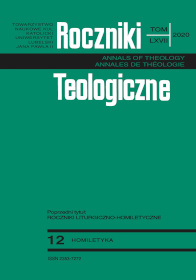Teologia poezji liturgicznej w przestrzeni sztuki. Analiza na przykładzie opery „Legenda o niewidzialnym grodzie Kiteziu i dziewicy Fiewronii”
Theology of Liturgical Poetry in the Space of Art: Analysis on the Example of the Opera “The Legend of the Invisible City of Kitezh and the Maiden Fevroniya”
Author(s): Iwan OstaszczukSubject(s): Christian Theology and Religion, Theology and Religion, Pastoral Theology
Published by: Towarzystwo Naukowe KUL & Katolicki Uniwersytet Lubelski Jana Pawła II
Keywords: liturgical poetry; theology; the Second Coming (Parousia); opera The Legend of the Invisible City of Kitezh and the Maiden Fevroniya; the hymn Here’s the Groom going
Summary/Abstract: The texts of liturgical poetry are important factors in the formation of works of musical art over the centuries of European music history. This article discusses the theology of liturgical poetry in the space of musical art. The reception of a particular liturgical work in the canvas of musical art creates a corresponding reading of its content in the light of the relevant Christian theological paradigm. Nikolai Rimsky-Korsakov in collaboration with librettist Vladimir Belsky in the opera-legend The Legend of the Invisible City of Kitezh and the Maiden Fevroniya used the textual allusions of the Ortodox church singing Here’s the Groom going. The use of church singing from Lent expresses in the finale of the opera the theological ideas of the Second Coming of Jesus Christ, and also presents a picture of the bliss of paradise being in the Kingdom of Heaven.
Journal: Roczniki Teologiczne
- Issue Year: 67/2020
- Issue No: 12
- Page Range: 137-148
- Page Count: 12
- Language: Polish

